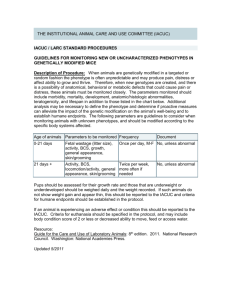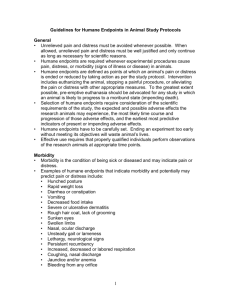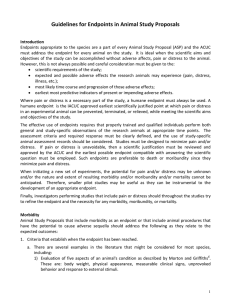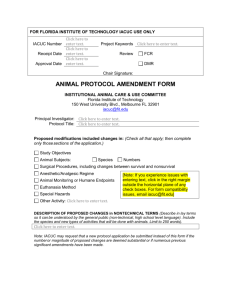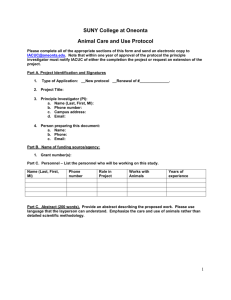Humane Endpoints in Animal Care and Use Protocols
advertisement
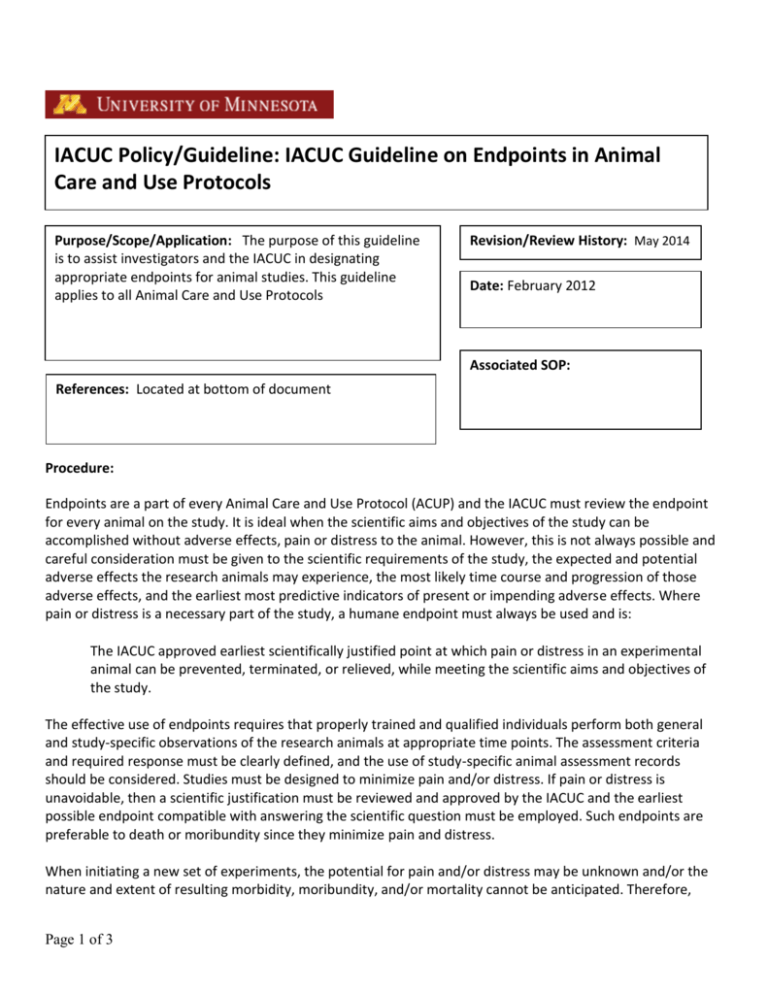
IACUC Policy/Guideline: IACUC Guideline on Endpoints in Animal Care and Use Protocols Purpose/Scope/Application: The purpose of this guideline is to assist investigators and the IACUC in designating appropriate endpoints for animal studies. This guideline applies to all Animal Care and Use Protocols Revision/Review History: May 2014 Date: February 2012 Associated SOP: References: Located at bottom of document Procedure: Endpoints are a part of every Animal Care and Use Protocol (ACUP) and the IACUC must review the endpoint for every animal on the study. It is ideal when the scientific aims and objectives of the study can be accomplished without adverse effects, pain or distress to the animal. However, this is not always possible and careful consideration must be given to the scientific requirements of the study, the expected and potential adverse effects the research animals may experience, the most likely time course and progression of those adverse effects, and the earliest most predictive indicators of present or impending adverse effects. Where pain or distress is a necessary part of the study, a humane endpoint must always be used and is: The IACUC approved earliest scientifically justified point at which pain or distress in an experimental animal can be prevented, terminated, or relieved, while meeting the scientific aims and objectives of the study. The effective use of endpoints requires that properly trained and qualified individuals perform both general and study-specific observations of the research animals at appropriate time points. The assessment criteria and required response must be clearly defined, and the use of study-specific animal assessment records should be considered. Studies must be designed to minimize pain and/or distress. If pain or distress is unavoidable, then a scientific justification must be reviewed and approved by the IACUC and the earliest possible endpoint compatible with answering the scientific question must be employed. Such endpoints are preferable to death or moribundity since they minimize pain and distress. When initiating a new set of experiments, the potential for pain and/or distress may be unknown and/or the nature and extent of resulting morbidity, moribundity, and/or mortality cannot be anticipated. Therefore, Page 1 of 3 smaller pilot studies may be useful as they can be instrumental to the development of an appropriate endpoint. Finally, investigators performing studies that include pain or distress should, during the conduct of the studies, try to refine the endpoint and eliminate the necessity for any morbidity and/or mortality. Morbidity ACUPs that include morbidity as an endpoint or animal procedures that have the potential to cause adverse effects should include criteria that establish when the endpoint has been reached and a plan for monitoring the animals, providing care if appropriate, and increasing the level of monitoring as necessary Death or Moribundity While it is preferable to use the earliest endpoints compatible with the scientific requirements of each study, there may be studies that require moribundity or mortality as an endpoint. The moribund condition is defined as a clinically irreversible condition leading inevitably to death. Commonly used signs of moribundity include, but are not limited to, lack of responsiveness to manual stimulation, immobility, and/or an inability to eat or drink. ACUPs utilizing death or moribundity as an endpoint should contain the following information: 1. The scientific rationale for death or moribundity as an endpoint, including what alternatives were considered, why morbidity as an endpoint cannot be used, the estimated number of animals that will be allowed to reach morbundity/death and whether animals will be euthanized when moribund and if not, what information is to be gained in the interval between moribundity and death. 2. Assurances that the frequency of observation will be increased when animals exhibit signs of morbidity and that written records will be kept of the monitoring and observations. References: Adapted from NIH intramural guidelines: http://oacu.od.nih.gov/ARAC/documents/ASP_Endpoints.pdf Alternatives to Animal Testing on the Web (2004), Humane Endpoints Database. (http://altweb.jhsph.edu/humane-endpoints.htm) Johns Hopkins Center for Alternatives to Animal Testing. Baltimore. Canadian Council on Animal Care (1998), Guidelines on: Choosing an appropriate endpoint in experiments using animals for research, teaching and testing. Ottawa, Canada. Hendriksen CFM and Morton DB, ed. (1998), Humane Endpoints in Animal Experiments for Biomedical Research. Proceedings of the International Conference, 22-25 November 1998, Zeist, The Netherlands. Laboratory Animals Ltd, by Royal Society of Medicine Press Limited, London, England. Page 2 of 3 Institute for Laboratory Animal Research Journal (2000), Humane Endpoints for Animals Used in Biomedical Research and Testing. 41: No. 2 Montgomery CA (1990), Oncological and toxicological research: Alleviation and control of pain and distress in laboratory animals. Cancer Bulletin 42:230-237. Morton DB and Griffiths PHM (1985), Guidelines on the recognition of pain, distress and discomfort in experimental animals and an hypothesis for assessment. Veterinary Record 116:431-43. OECD Guidance Document on the Recognition, Assessment, and Use of Clinical Signs as Humane Endpoints for Experimental Animals Used in Safety Evaluation (2000) http://www.oecd.org/officialdocuments/displaydocumentpdf?cote=env/jm/mono(2000)7&doclanguage=e n Netherlands Centre Alternatives to Animal Use http://www.vet.uu.nl/nca/documents/humane_endpoints Ray MA, et al (2010) Identification of Markers for Imminent Death in Mice Used in Longevity and Aging Research. JAALAS 48(3):282-288 Recognition and Alleviation of Pain In Laboratory Animals; NRC 2009 Stokes WS (1999), Humane Endpoints in Animal Experiments for Laboratory Animals Used in Toxicity Testing Proceedings of the 3rd World Congress on Alternatives and Animal use in the Life Sciences, 31 August - 2 September 1999, Bologna, Italy. Toth (1997), The moribund state as an experimental endpoint. Contemp Top Lab Anim Sc 36:44-48. Ullman-Culleré MH and Foltz CJ (1999), Body condition scoring: a rapid and accurate method for assessing health status of mice. Lab Anim Sc 49:319-323. United Kingdom Co-ordinating Committee on Cancer Research (1997), UKCCCR Guidelines for the Welfare of Animals in Experimental Neoplasia, 2nd ed. London, England. Page 3 of 3


